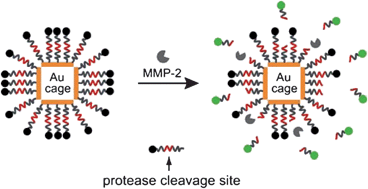 New Nanoscale Communication
New Nanoscale Communication
An enzyme-sensitive probe for photoacoustic imaging and fluorescence detection of protease
Xiaohu Xia, Miaoxin Yang, L. Kyle Oetjen, Yu Zhang, Qingge Li, Jingyi Chen and Younan Xia
Nanoscale, 2011, DOI: 10.1039/C0NR00874E
A particularly exciting aspect of research into new nanotechnology is the design and synthesis of multimodal nanomaterials. These are generally nanostructures which incorporate several different functional materials, such as magnetic and fluorescent substances, into a single structure which can then perform several tasks in parallel. It is anticipated that this sort of approach will improve the performance and efficiency of diagnostic and therapeutic nanomaterials in biomedical applications.
In this communication, Xia et al. describe their development of a new imaging probe constructed from gold nanocages functionalised with fluorescent dyes. Gold nanocages are already considered to be good candidates as contrast agents for optical imaging due to their tunable localized surface plasmon resonance features in the near-infrared region, and their compact sizes (<50 nm). They are of particular use in photoacoustic imaging due to their strong light absorption in the near-infrared, which can drastically improve contrast.
The team behind this work has extended the functionality of these gold nanocages by attaching dye molecules which will only fluoresce in the presence of protease (specifically, matrix metalloproteases, MMPs), a common indicator for cancer cell metastasis. In practice, this means that the distribution of the gold nanocages in targeted lesions can be mapped by photoacoustic imaging, while protease activity can be simultaneously mapped using fluorescence spectroscopy or microscopy.
Read this exciting work here.










